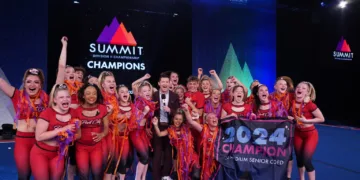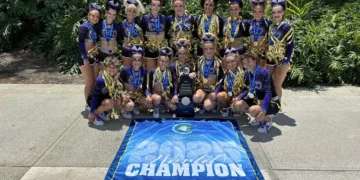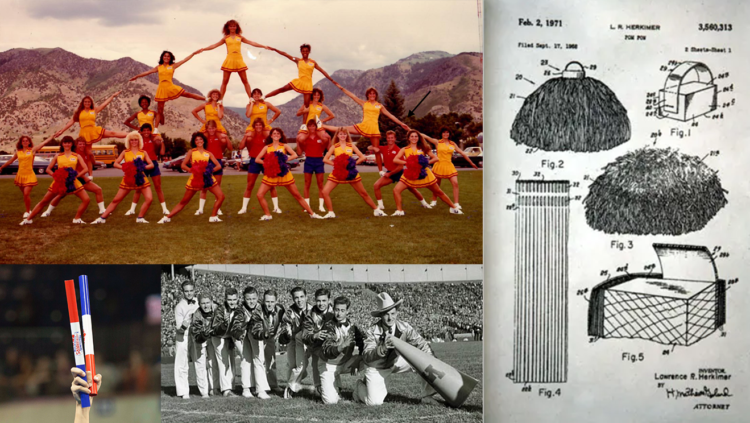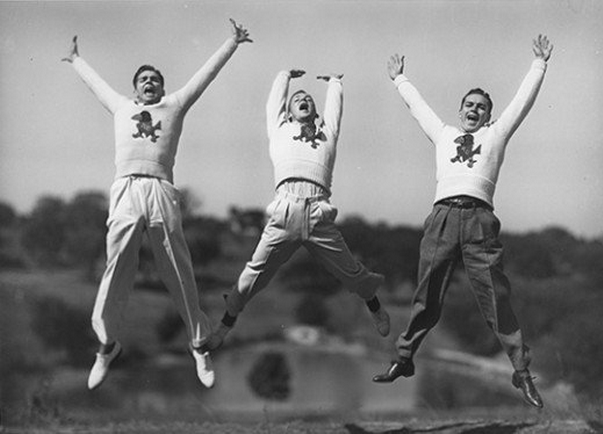
The Dawn of Cheer
1860
The initial spark for organized cheering emerged in the 1860s at Ivy League sports events, where crowds unified in support, forming the foundation of modern cheerleading.
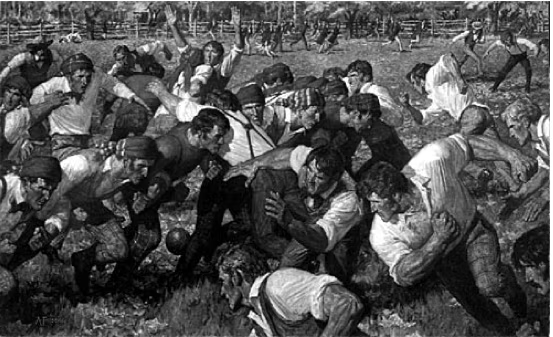
College Football's Beginnings
Nov. 6, 1869
The first intercollegiate football game between Princeton and Rutgers brought fans together in a lively, spirited display, cementing enthusiastic crowd support as a staple in sports.
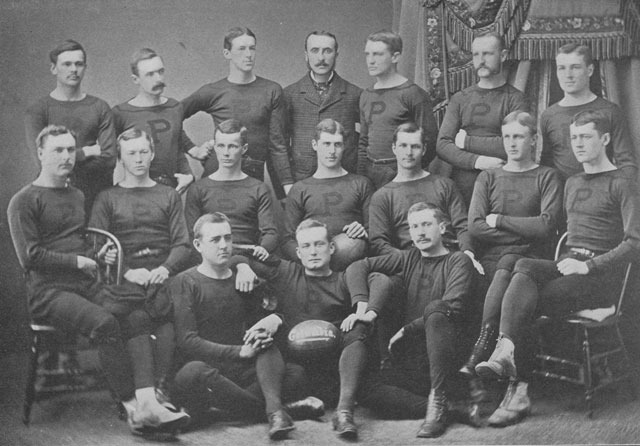
The First Official "Cheer"
1884
The earliest documented cheer was shouted at Princeton, stirring crowd energy with a catchy, memorable chant: Ray, Ray, Ray! Tiger, Tiger, Tiger! Sis, Sis, Sis! Boom, Boom, Boom! Aaaaah! Princeton, Princeton, Princeton! This cheer laid the groundwork for crowd-driven enthusiasm that we still see today.
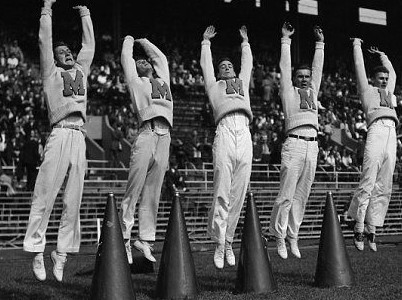
Organized Cheering Begins
Oct 26, 1897
In the 1880s, the concept of organized crowd cheering spread beyond Princeton. Thomas Peebles, a Princeton graduate from the class of 1882, moved to Minnesota in 1884 and brought this budding tradition with him. Inspired by the pep club culture at Princeton, Peebles introduced the idea of unified crowd support at the University of Minnesota, laying essential groundwork for cheerleading’s future in college sports across the United States.

The First Cheerleader
November 2, 1898
Cheerleading took a significant step forward on November 2, 1898. Until this date, crowd cheers were spontaneous and often uncoordinated, with groups attempting to rally in different chants. But on that day, Johnny Campbell, a student at the University of Minnesota, leapt over the fence and took the field to lead the crowd himself—a bold move that birthed organized cheerleading as we know it. Campbell's unifying chant went: Rah, Rah, Rah! Ski-u-mah! Hoo-Rah! Hoo-Rah! Varsity! Varsity! Varsity, Minn-e-So-Tah! This electrifying moment is celebrated as the "birthday of cheerleading" each year on November 2, honoring the day cheerleading became more than just chants from the crowd—it became a spirited, organized activity led by passionate leaders like Campbell.
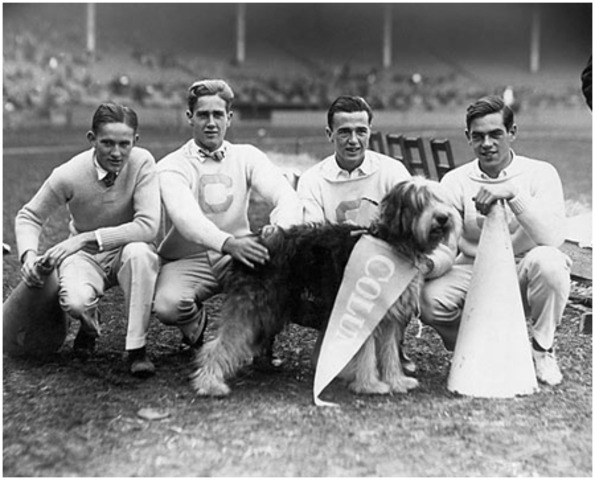
Gamma Sigma
January 1, 1903
On January 1, 1903, the University of Minnesota established a six-member fraternity, Gamma Sigma, marking a pivotal moment in cheerleading history. This all-male squad was dedicated to leading the student section in coordinated cheers, making them one of the first official "yell-leader" squads in the nation. Their presence boosted the volume and energy of the crowd, fueling a belief that a louder, more spirited student section could influence the outcome of games. Gamma Sigma set a standard for organized cheerleading, showcasing the power of unified fan support to rally a team.
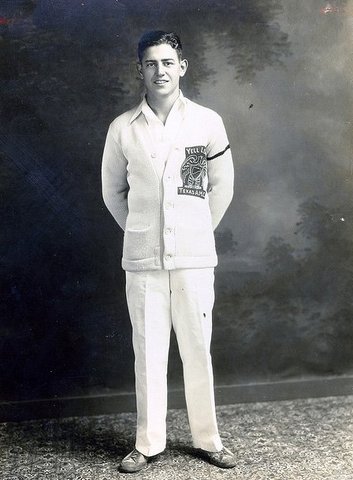
Texas A&M Yell Leaders Established
January 1, 1907
In 1907, Texas A&M University founded its iconic Yell Leaders squad, an all-male group of five students responsible for leading cheers and rallying school spirit. Unlike other cheer teams, Texas A&M’s Yell Leaders were, and remain, uniquely rooted in tradition as a male-only squad. These five Yell Leaders became the heart of Aggie spirit, fostering an atmosphere of unity and enthusiasm that continues today. The Yell Leaders are a key part of Texas A&M's culture, representing over a century of tradition and spirited support for the Aggies.
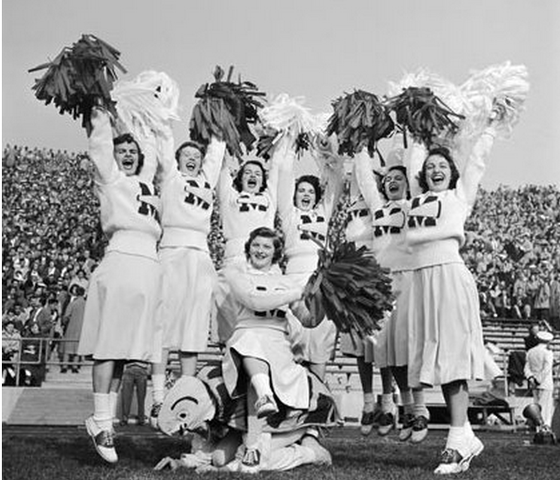
Women Officially Join Cheerleading at the University of Minnesota
1923
In 1923, the University of Minnesota broke new ground by permitting women to join their cheerleading teams, a notable moment in cheer history. However, the integration of women into cheerleading was slow to spread to other schools. As late as the late 1920s, school manuals and newspapers still referred to cheerleaders using terms like “chap,” “fellow,” and “man,” reflecting the longstanding perception of cheerleading as a male activity. Despite this resistance, the presence of women in cheerleading continued to grow, gradually reshaping the identity of the sport.
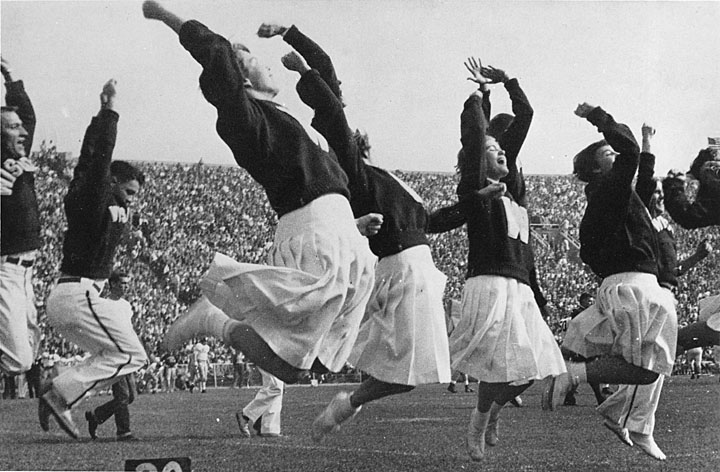
Women Take Center Stage in Cheerleading
1940
The 1940s marked a turning point for women in cheerleading. As college-aged men were drafted into World War II, women gained unprecedented opportunities to step into cheerleading roles on the sidelines of sporting events. Author Kieran Scott notes in Ultimate Cheerleading: “Girls really took over for the first time,” capturing the significance of this era. With male cheerleaders away, women not only filled their spots but began to reshape the sport, establishing a strong female presence that would ultimately transform cheerleading into a predominantly female activity.
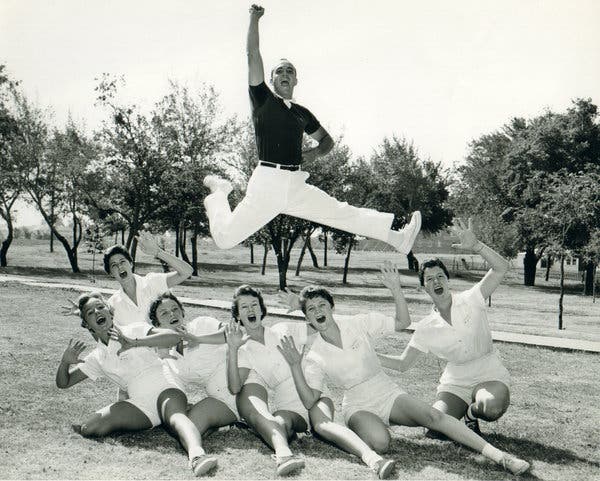
Lawrence Herkimer Launches the First Cheerleading Camp
1948
In 1948, Lawrence “Herkie” Herkimer hosted his first cheerleading camp at Sam Houston State Teachers College (now Sam Houston State University) in Huntsville, Texas. Drawing 52 girls—and one boy—the camp marked the beginning of Herkimer's transformative influence on the cheerleading world. By the following year, attendance had skyrocketed to 350 campers, underscoring the demand for structured cheerleading training. Herkimer’s vision didn’t come without challenges. To get his cheerleading camp business off the ground, he borrowed $600 from a friend of his father-in-law and started his venture in his Dallas garage. This bold move laid the groundwork for the modern cheer industry, turning his passion into a full-fledged business and establishing cheer camps as a key training ground for young cheerleaders nationwide.
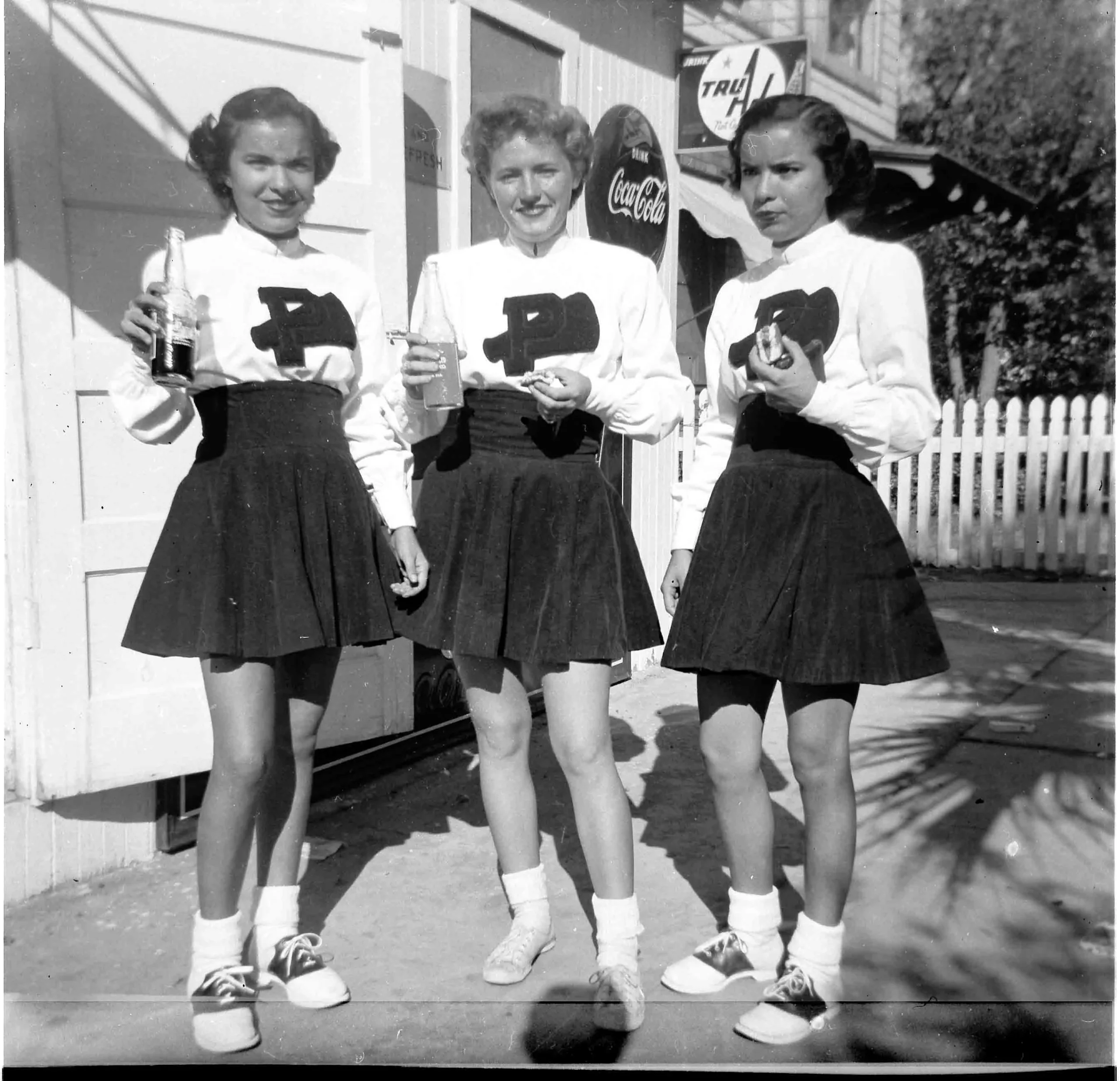
The Rise of Female Participation in Cheerleading
1950
During the 1950s, female participation in cheerleading continued to grow. An overview written on behalf of cheerleading in 1955 explained that in larger schools, "occasionally boys as well as girls are included", and in smaller schools, "boys can usually find their place in the athletic program, and cheerleading is likely to remain solely a feminine occupation". Cheerleading could be found at almost every school level across the country; even pee wee and youth leagues began to appear.
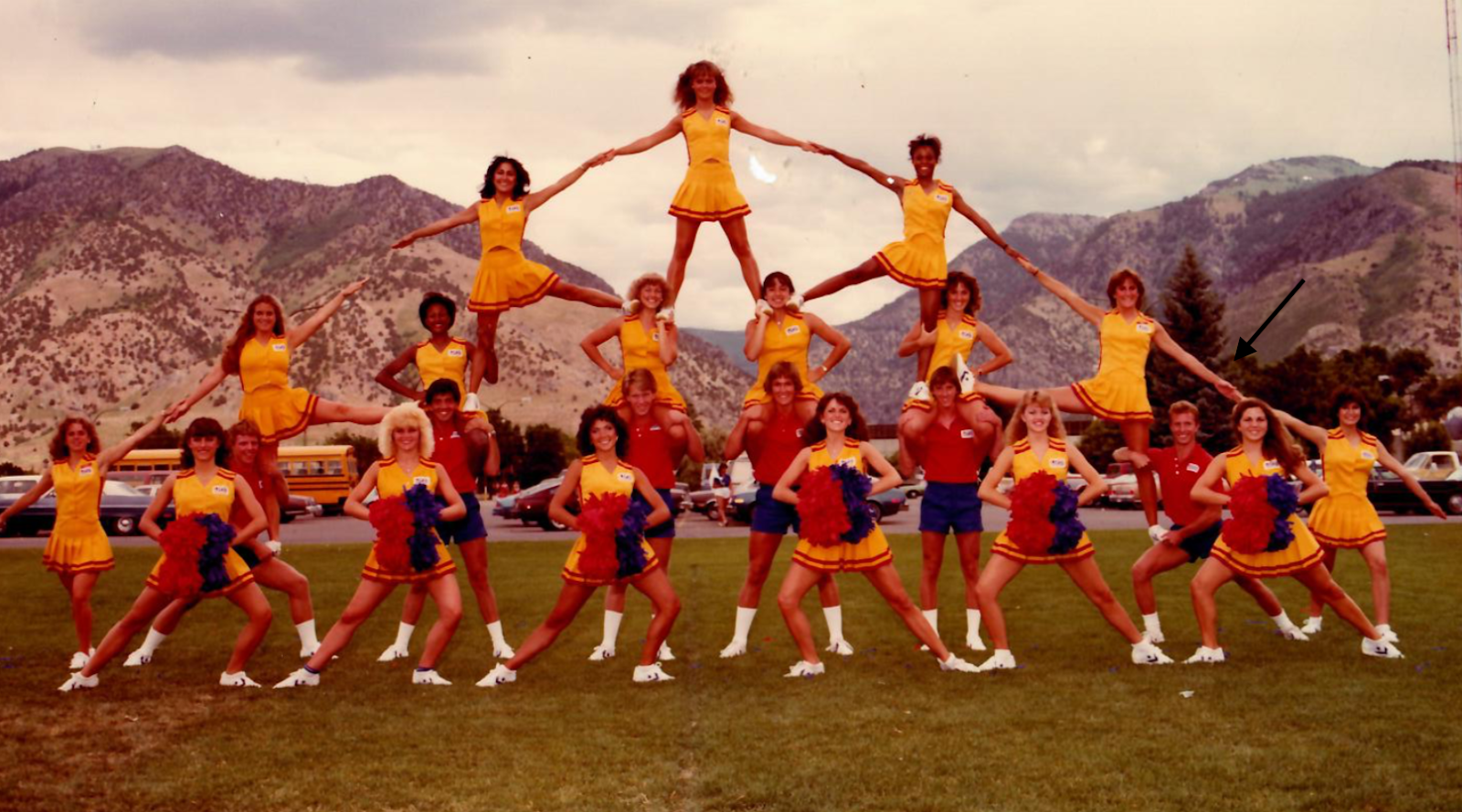
The United Spirit Association (USA) is Founded
1950
In 1950, Robert Olmstead established the United Spirit Association (USA), originally known as “California Specialty Camps.” USA began as a program dedicated to specialized instruction across a range of spirit and performance activities, including cheerleading, song leading, pom and dance teams, drum majors, mascots, pep flags, and drill teams. Unlike other cheer organizations, USA’s mission encompassed a broader spectrum of spirit-based groups, offering instruction to advisors, directors, and coaches as well. Through USA, students received quality training in a supportive, creative environment that encouraged both skill development and friendship. Today, USA remains a leader in spirit instruction, helping students across various disciplines to excel while fostering a positive and inclusive learning atmosphere.
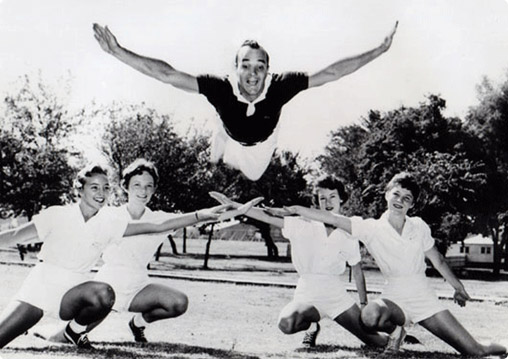
The National Cheerleaders Association (NCA) is Founded
1951
In 1951, Lawrence "Herkie" Herkimer officially established the National Cheerleaders Association (NCA), marking a new era in cheerleading education and training. Created to expand and professionalize cheerleading, the NCA was the first organization dedicated to teaching crowd-leading techniques, partner stunts, and jumps to young cheerleaders nationwide. Herkimer’s efforts inspired the creation of similar organizations across the U.S., which began hosting cheer camps to train and develop cheerleaders. The NCA's growth was explosive. By the height of its summer programs, the organization employed around 1,500 instructors, training tens of thousands of eager cheerleaders on college campuses across the country. In addition to camps, Herkimer launched the Cheerleader Supply Company to provide essential cheer apparel—sweaters, skirts, and more. Though not his favorite aspect of the business, outfitting squads proved to be the most profitable, supporting the NCA’s mission to elevate cheerleading as both an art and a sport.

The Birth of Professional Cheerleading
1954
In 1954, the Baltimore Colts made NFL history by becoming the first team to incorporate cheerleaders into their organization. Known as the Marching Colts, these cheerleaders were part of a larger marching band ensemble, bringing added spirit and energy to the Colts' games. This historic move introduced cheerleading to professional football, paving the way for the iconic NFL cheer squads that would follow. The Marching Colts marked the beginning of cheerleading’s journey into mainstream professional sports entertainment.
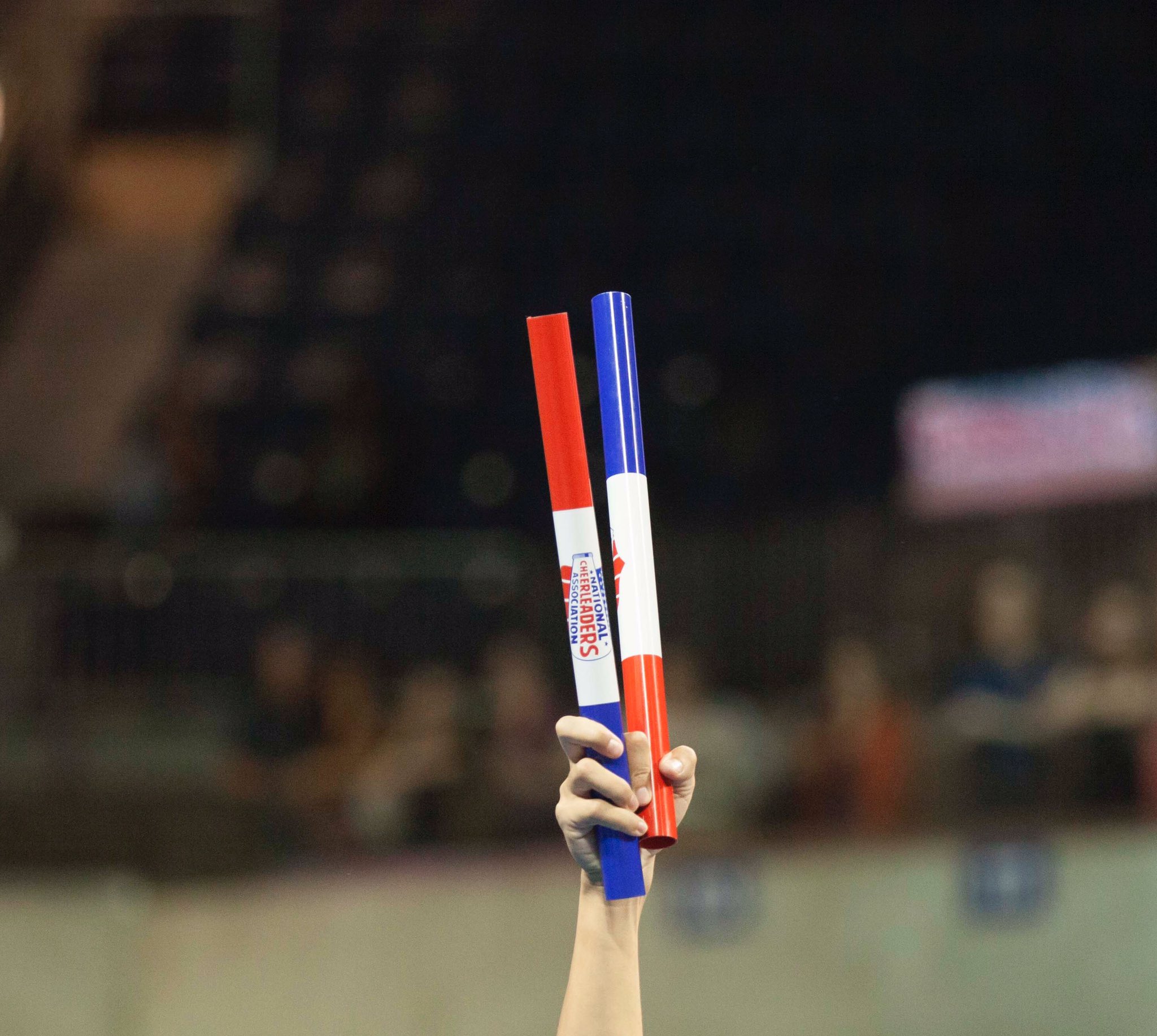
The Creation of the Iconic Spirit Stick
1954
In 1954, Lawrence “Herkie” Herkimer introduced a now-beloved symbol of cheerleading—the spirit stick. During an NCA camp, Herkimer observed a squad that, while not the most skilled in execution, displayed exceptional hard work and an uplifting attitude, encouraging other teams with unmatched spirit. Moved by their positivity, Herkimer crafted a makeshift award from a small tree branch, painting and decorating it before presenting it to the team in front of the entire camp. The spirit stick quickly became a cherished tradition, representing the values Herkimer believed were at the heart of cheerleading: teamwork, spirit, and support. Today, receiving the spirit stick is one of the highest honors at cheer camps across the country, symbolizing the unity and enthusiasm that make cheerleading unique.
Herkimer Expands Cheerleading Camps Nationwide
1960
By the late 1960s, Herkimer was hiring hundreds of instructors for more than 150 camps teaching 100,000 high school cheerleaders around the country.
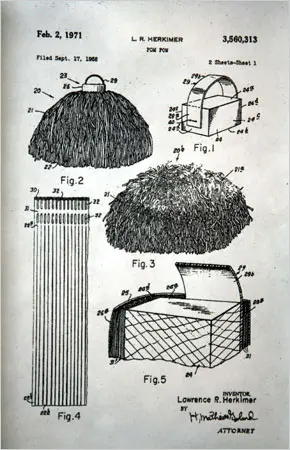
The Iconic Pom Pon is Patented
1971
Lawrence “Herkie” Herkimer, always innovating to enhance cheerleading's visual appeal, responded to the rise of color television by designing vibrant crepe-papered pompoms mounted on sticks. Recognizing the power of eye-catching props, he eventually developed the hidden-handled design of what he called the pom pon—a name chosen after discovering that "pompom" carried unintended meanings in some cultures. In 1971, Herkimer's creation received U.S. Patent No. 3,560,313, setting the standard for pom pons in cheerleading and helping to make them an iconic, essential accessory for teams across the country.

Jeff Webb Joins the National Cheerleaders Association
1971
In 1971, Jeff Webb joined Lawrence Herkimer's National Cheerleaders Association (NCA) full-time, a decision that would shape the future of cheerleading. Webb, who had worked part-time for Herkimer during college, quickly rose to prominence, eventually becoming the head instructor at some of the NCA's largest camps. Herkimer, who had no sons and saw Webb as a protégé, famously told him, “I’ve been waiting 25 years for you to come along.” Encouraging Webb to forego his plans for law school, Herkimer urged him to build a career in cheerleading. At just 23, Webb accepted the challenge and took on the role of general manager of the NCA. Webb’s leadership would eventually lead to transformative contributions in cheerleading, from founding new organizations to expanding competitive cheer across the globe. His journey began with Herkimer’s mentorship, a pivotal moment in cheer history that propelled Webb to become one of the sport's most influential figures.
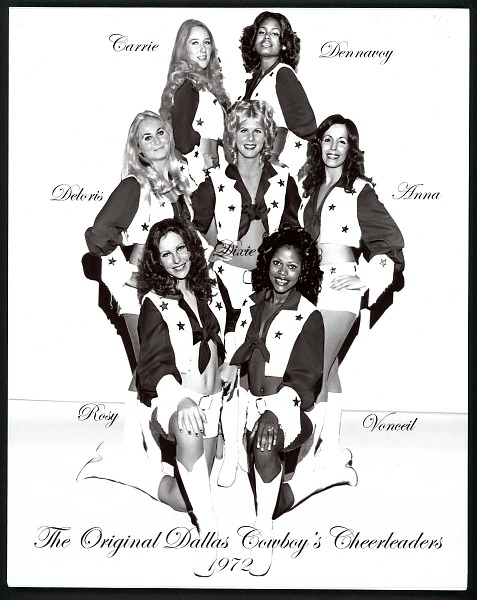
The Dallas Cowboys Cheerleaders Steal the Spotlight
1972
The Dallas Cowboys Cheerleaders brought a new level of sophistication and visibility to professional cheerleading when they debuted in the 1972-1973 season. Known for their signature, more revealing outfits and polished dance routines, the squad quickly captured national attention. Their fame skyrocketed after performing at Super Bowl X in 1976, where they captivated the audience and solidified their place as cultural icons. The Dallas Cowboys Cheerleaders redefined professional cheerleading, inspiring a wave of similar squads across the NFL and shaping cheerleading’s image in popular culture.

Jeff Webb Founds Universal Cheerleaders Association and Varsity Spirit
1974
In 1974, driven by a desire to modernize and elevate cheerleading, Jeff Webb founded the Universal Cheerleaders Association (UCA) and Varsity Spirit. Frustrated with Lawrence Herkimer’s traditional approach—which emphasized spirit sticks, basic cheers, and modest stunts—Webb envisioned a new direction for cheerleading, one that emphasized advanced stunts, athleticism, and competitive rigor. Breaking from the National Cheerleaders Association (NCA), he recruited 20 of Herkimer’s top instructors and launched UCA, setting a bold new standard for the sport. UCA began with training camps and clinics designed to enhance skills for high school and college cheerleaders. Unlike NCA, UCA quickly incorporated cheerleading competitions into its offerings, helping to drive the growth of cheerleading as a competitive sport. Alongside UCA, Webb also launched Varsity Fashions, an apparel and accessory brand that has since become a leading provider of cheer gear. Webb’s innovations transformed cheerleading, creating a pathway for the sport's athletic and competitive evolution.

Cheerleading's Rapid Growth and Demographic Shift
1975
By 1975, cheerleading had become a staple activity across American schools. Randy Neil estimated that more than 500,000 students actively participated in cheerleading, from elementary schools to college campuses. This period also highlighted a major demographic shift: approximately 95% of American cheerleaders were female, solidifying the sport's association with women and young girls. Neil’s findings underscored cheerleading’s explosive growth and its evolving identity as an activity predominantly led by women.

National Dance Alliance (NDA) is Founded
1976
In 1976, Lawrence Herkimer, the pioneer of modern cheerleading, founded the National Dance Alliance (NDA), originally named NCA Superstar. This organization, an extension of the National Cheerleaders Association (NCA), aimed to provide comprehensive dance training and choreography for dance teams across the U.S. Today, NDA offers a complete, well-rounded curriculum with choreography crafted by industry leaders, supporting dancers in skill development and performance artistry. NDA hosts camps at hundreds of locations nationwide and also offers private camps, making high-quality dance instruction accessible to teams of all levels. NDA’s growth reflects Herkimer’s vision of expanding cheer and dance education, helping thousands of dancers improve their skills and connect with peers across the country.

Competitive Cheerleading Makes Its Television Debut
April 24, 1978
On April 24, 1978, competitive cheerleading stepped into the national spotlight with the first televised broadcast of the Collegiate Cheerleading Championships on CBS. This historic broadcast introduced America to the athletic and competitive side of cheerleading, showcasing high-level skills, synchronized routines, and the intense dedication of college cheerleaders. The exposure helped elevate cheerleading from a sideline activity to a recognized competitive sport, inspiring a new generation of athletes and expanding cheerleading’s popularity nationwide.
Emergence of All-Star Cheerleading
Early 1980
During the early 1980s, a new type of cheerleading team began to take shape—squads that were not affiliated with a school or sports league and focused solely on competition. These independent teams, later known as All-Star teams, marked a shift from traditional sideline cheer to performance-based routines centered on stunts, tumbling, and high-energy choreography.

Universal Dance Association (UDA) Founded
1980
In 1980, Jeff Webb and Kris Shepherd founded the Universal Dance Association (UDA), starting with dance camps focused on providing specialized training for dancers. UDA quickly expanded, becoming the largest dance company in the U.S., and today trains over 40,000 dancers each summer at more than 760 camps nationwide. UDA offers a variety of camp experiences, including private camps, technique camps, and choreography camps, to support dancers at all levels. The organization’s mission is to elevate dance education and provide high-quality instruction, empowering dancers to refine their technique and performance. UDA's influence has been instrumental in popularizing and professionalizing dance within the spirit and cheer community.
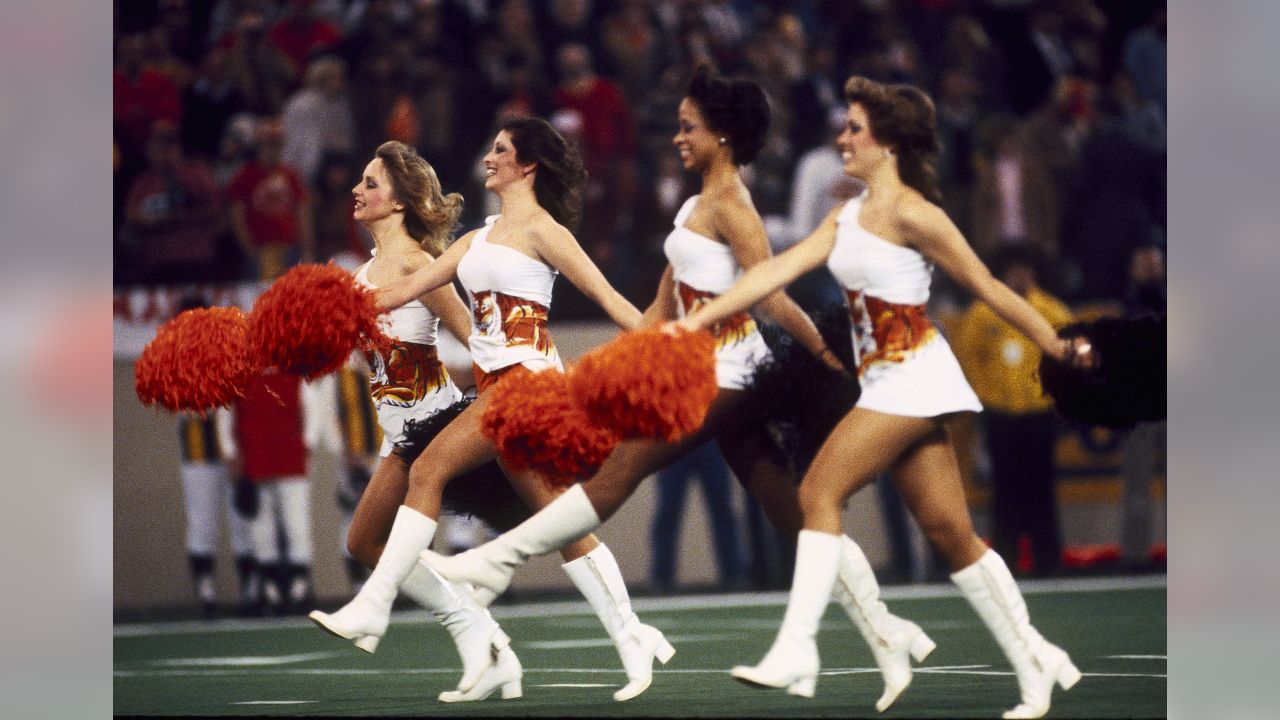
NFL Cheerleading Expands Across the League
1981
By 1981, 17 NFL teams had established their own cheerleading squads, adding energy, entertainment, and spirit to game days. Only nine teams—New Orleans, New York, Detroit, Cleveland, Denver, Minnesota, Pittsburgh, San Francisco, and San Diego—had yet to introduce cheerleaders to their sidelines. This growing trend soon spread beyond football, with professional cheerleading squads becoming fixtures for basketball and soccer teams as well. The expansion of professional cheerleading to multiple sports leagues solidified its place in American sports culture, merging athleticism with performance art across various fan bases.
The First All-Star Cheer Team – Q94 Rockers
1982
The Q94 Rockers, founded in 1982 in Richmond, Virginia, were the first cheerleading team to identify themselves as All-Stars. Unlike traditional teams tied to schools or sports leagues, the Q94 Rockers focused solely on competition, marking a departure from cheer’s sideline roots. In these early days, All-Star teams like the Rockers competed in the same divisions as school and league-affiliated squads, as separate divisions for non-school teams did not yet exist.

ESPN Brings High School Cheerleading to a National Audience
1983
In 1983, ESPN aired the National High School Cheerleading Competition for the first time, introducing viewers across the country to the intensity, skill, and spirit of high school cheerleading. This broadcast was a game-changer, bringing widespread recognition to competitive cheerleading at the high school level and showcasing it as a disciplined and athletic sport. The national exposure helped cheerleading gain legitimacy and fueled its growth as a competitive endeavor in schools across the U.S..
American Cheer Power is Established
1985
In 1985, Regina Symons founded American Cheer Power with a strong focus on athlete development and safety. Cheer Power provides a variety of camps, including private, stunt, choreography, youth camps, and the recently introduced Cheer Boot Camp. Each camp prioritizes skill progression while emphasizing the safety and well-being of every athlete. American Cheer Power has become known for its athlete-centered approach, providing structured, safe environments where cheerleaders can advance their skills across a range of focus areas.

Establishing Safety Standards in Cheerleading
1987
As cheerleading routines grew more complex and physically demanding, the need for safety became paramount. In 1987, organizations like the American Association of Cheerleading Coaches and Advisors (AACCA) were founded to create and enforce universal safety standards. The AACCA, a non-profit association, dedicated itself to educating over 50,000 cheerleading coaches across the United States on safe practices. Its guidelines restricted hazardous stunts, pyramids, and tumbling passes, helping to reduce the risk of injuries in youth, junior high, high school, and college cheerleading. By emphasizing responsible coaching and safety-focused routines, AACCA set a new standard, ensuring that cheerleading could be both exciting and safe for participants nationwide. Today, AACCA’s influence remains foundational in maintaining cheer safety across levels.

Varsity Spirit's Explosive Growth
1990
The 1990s marked a period of rapid expansion for Varsity Spirit. During this decade, Varsity gained significant market share and saw its revenue quintuple, soaring to $136 million by the end of the 1990s. This explosive growth reflected the rising popularity of competitive cheerleading, driven in part by Varsity’s dominance in camps, competitions, and apparel. Jeff Webb’s vision of cheerleading as a dynamic, competitive sport transformed the industry, with Varsity Spirit leading the charge as cheer gained recognition and commercial success nationwide.
Cheerleading Technique Camps (CTC) Established
1991
n 1991, Jim Thorp founded Cheerleading Technique Camps (CTC) with the mission of providing high-quality, cost-effective cheer camps tailored specifically to each team’s needs. Unlike traditional cheer camps, CTC focused on custom private camps that allowed teams to receive specialized training in a more personalized setting. CTC quickly gained a reputation for delivering targeted cheer instruction that meets the unique goals and skill levels of individual teams, making it a popular choice for teams looking to advance their skills in a customized camp environment. CTC’s emphasis on affordability and customization continues to set it apart in the cheer camp industry.
Varsity Spirit Goes Public
January 1992
In January 1992, Varsity Spirit, the umbrella company created by Jeff Webb for his expanding cheerleading empire, went public. By this time, Varsity had become a powerhouse in the cheer industry, with 100,000 athletes attending its summer camps each year and generating $28.1 million in annual revenue. The company's rapid growth reflected Webb's vision of transforming cheerleading into a thriving competitive and training-focused industry, positioning Varsity Spirit as a leader in cheer camps, competitions, and apparel. Going public marked a significant milestone for Varsity, solidifying its role in shaping modern cheerleading.
Spirit Xpress Cheerleading is Founded
1992
In 1992, Don Collins launched Spirit Xpress Cheerleading with the goal of providing summer training tailored for competitive cheerleading squads in a supportive, non-competitive environment. Spirit Xpress focuses on skill development, customizing its training to align with each squad’s specific needs. By creating a camp experience centered on skill building rather than competition, Spirit Xpress has become a popular choice for teams looking to advance their abilities in a collaborative and encouraging atmosphere.
CHEERSPORT is Founded
1993
Founded in 1993 by All-Star cheer coaches, CHEERSPORT was established with a mission to create competitions that would benefit athletes, coaches, and spectators alike. These founding coaches envisioned a competition model centered on enhancing the experience for everyone involved in cheerleading. CHEERSPORT’s flagship event, CHEERSPORT Nationals, has since become one of the largest and most popular cheer competitions in the United States. Held each February at the Georgia World Congress Center in Atlanta, Georgia, CHEERSPORT Nationals attracts teams from across the country, showcasing high-level cheerleading in a premier, athlete-centered environment.
Varsity Acquires United Spirit Association (USA) Cheer Camps
1994
In 1994, Varsity Spirit expanded its reach by acquiring the United Spirit Association (USA) Cheer Camps, the largest summer cheer camp provider in the Western United States. Known for its extensive camp programs, USA operated primarily in Arizona, Arkansas, California, Colorado, Hawaii, Idaho, Montana, New Mexico, Nevada, Oregon, Texas, Utah, Washington, and Wyoming. This acquisition strengthened Varsity’s presence in cheerleading training and provided athletes in the Western U.S. with enhanced access to Varsity’s expertise and resources, further establishing Varsity’s leadership in the cheer camp industry.

American Cheerleader Magazine Launches as Lifestyle Ventures' Flagship Publication
January 1995
Founded by Lifestyle Ventures in 1994, American Cheerleader magazine released its premiere issue in February 1995. As the flagship magazine of Lifestyle Ventures, American Cheerleader was dedicated to covering the rapidly expanding cheerleading industry. The publication offered content on technique, training, competitions, and team features, quickly establishing itself as the leading source of cheer news and insights. Its launch provided a central platform that connected the cheer community, celebrating the sport’s athleticism and culture while helping to elevate cheerleading in the public eye.
Varsity Acquires United Special Events
1996
In 1996, Varsity Spirit continued its expansion by acquiring United Special Events, a major camp promoter in California. This acquisition further strengthened Varsity’s footprint on the West Coast and enhanced its ability to deliver premier cheerleading training and events. United Special Events brought additional regional expertise and access to California’s growing cheer community, aligning with Varsity’s mission to provide quality cheer camps and events across the U.S.
The JAM Brands Founded
1996
Headquartered in Louisville, Kentucky, The JAM Brands was a significant provider of products and services for the cheerleading and dance industry, encompassing approximately 12 brands that offered everything from competitions and camps to uniforms, merchandise, and apparel. Originally an independent entity, The JAM Brands is now part of Varsity Brands following Varsity’s acquisition. JAMfest, the original brand of The JAM Brands, was founded in 1996 by Aaron Flaker and Emmitt Tyler. JAMfest quickly became known for its high-energy events and innovative approach, helping to establish The JAM Brands as a major force in the cheerleading and dance world before joining Varsity’s portfolio.
Riddell Acquires Varsity Spirit, Inc.
June 1997
In June 1997, Riddell, a leading manufacturer of sports equipment, acquired Varsity Spirit, Inc. and its subsidiaries for $91 million. This acquisition marked a significant moment for Varsity, as it aligned the brand with Riddell's established reputation in the sports industry. Following the acquisition, Jeff Webb, then President and CEO of Varsity, transitioned to Vice Chair of the Board of Directors. The acquisition supported Varsity’s continued growth, helping it reach new heights in the cheerleading industry and enhancing its resources for camp, competition, and apparel development.
American Cheerleaders Association (ACA) is Founded
1998
In 1998, Lance Wagers established the American Cheerleaders Association (ACA) with a mission that extended beyond traditional awards like ribbons and trophies. ACA aimed to make a meaningful impact on each cheerleader, emphasizing personal growth, leadership, and quality training. Known for its personal touch and commitment to excellence, ACA offers a leadership program for campers and coaches, promoting skills that extend beyond cheer routines. By focusing on the development of both athletic and leadership qualities, ACA has carved out a distinctive role in the cheer camp industry.
All Star Cheerleading Gyms See Explosive Growth
Early 2000
In the early 2000s, All Star cheerleading saw unprecedented expansion, with the number of specialized gyms dedicated to advanced tumbling and stunting skyrocketing from around 200 to 2,500 in just five years. This surge reflected the rising demand for competitive cheer training, as more athletes pursued All Star cheerleading’s high-energy routines and ambitious stunts. The boom in All Star gyms highlighted the sport’s evolution and its appeal to those seeking a more athletic, competitive cheer experience beyond the sidelines.

Bring It On Hits Theaters and Becomes a Cultural Phenomenon
August 25, 2000
Released on August 25, 2000, Bring It On is an American teen comedy directed by Peyton Reed and written by Jessica Bendinger. Starring Kirsten Dunst, Eliza Dushku, Jesse Bradford, and Gabrielle Union, the film follows two high school cheerleading teams as they prepare for a national competition. Upon its release, Bring It On debuted at the number 1 spot in North American theaters and held that position for two weeks, ultimately grossing $90 million worldwide. The film received generally positive reviews, praised for its humor and portrayal of competitive cheerleading, and it quickly gained status as a cult classic. By spotlighting the athleticism, rivalry, and intensity of cheerleading, Bring It On helped redefine public perceptions of the sport, sparking increased interest and a new generation of cheerleaders inspired by its portrayal of the All Star cheerleading culture.
Varsity Spirit Goes Public
2001
Between 2001 and 2003, Varsity Spirit operated as a publicly traded company, marking a unique period in its corporate history. Going public allowed Varsity to access additional capital, fueling its growth in the cheerleading and dance industry. During this time, Varsity continued to expand its reach in camps, competitions, and apparel, further solidifying its leadership position. However, after two years on the public market, Varsity returned to private ownership, continuing its mission to support and shape the cheer industry.
Varsity Spirit Goes Private and Becomes Varsity Brands, Inc.
2003
In 2003, private equity firm Leonard Green & Partners took Varsity Spirit private in a deal valued at $131 million. This transition included a rebranding, changing the company’s name to Varsity Brands, Inc. The new name reflected Varsity’s broadened focus beyond cheerleading to include a full range of products and services that promote school spirit, sports, and team pride. Under Leonard Green & Partners’ ownership, Varsity Brands continued its growth, expanding its influence across cheerleading, dance, and other school-affiliated activities.
National All-Star Cheerleading Coaches Congress (NACCC) Founded
2003
In 2003, a group of cheerleading coaches established the National All-Star Cheerleading Coaches Congress (NACCC), an independent 501(c)(3) organization, with the goal of creating standardized rules for All-Star cheerleading. Open to event producers, coaches, and gyms, the NACCC brought together voices from across the industry to develop the first universal set of rules for All-Star cheer. This initiative was a critical step toward unifying the sport, ensuring safety, fairness, and consistency across competitions, and setting the stage for the future growth and organization of All-Star cheerleading.
Varsity Establishes the USASF
2003
In 2003, Varsity Brands joined forces with other cheerleading promoters to form the United States All Star Federation (USASF), an organization dedicated to setting standards and promoting safety in All-Star cheerleading. Varsity played a pivotal role in supporting the USASF’s launch, providing initial capital through a $1.8 million interest-free loan. This financial support allowed the USASF to develop essential resources and implement universal rules, helping to bring greater structure, safety, and credibility to the rapidly growing All-Star cheerleading industry.
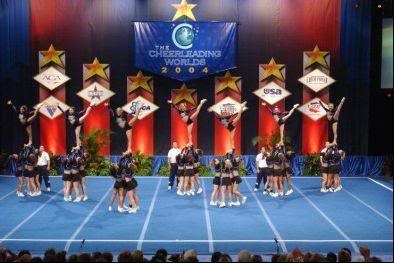
Inaugural USASF Cheerleading World Championship
April 24, 2004
The first USASF Cheerleading World Championship took place on April 24, 2004, marking a historic milestone in competitive cheer. This exclusive, invite-only event featured just two divisions—Senior All-Girl Level 5 and Senior Coed Level 5—with only 14 teams competing. Held at a backstage sound stage at Disney’s MGM Studios (now Disney’s Hollywood Studios) at Walt Disney World, the venue could accommodate a maximum of 500 spectators. At this initial championship, winners received jackets as their awards, similar to the traditions at NCA and UCA events, as opposed to the championship rings awarded in later years. In the Senior All-Girl Level 5 division, Cheer Athletics won the gold, followed by Maryland Twisters F5 with the silver, and American Cheer taking bronze. In the Senior Coed Level 5 division, Miami Elite took the gold, Spirit of Texas earned silver, and Memphis Elite claimed the bronze. The USASF World Championship has since grown into one of the most prestigious events in competitive cheerleading, attracting top teams from around the world.
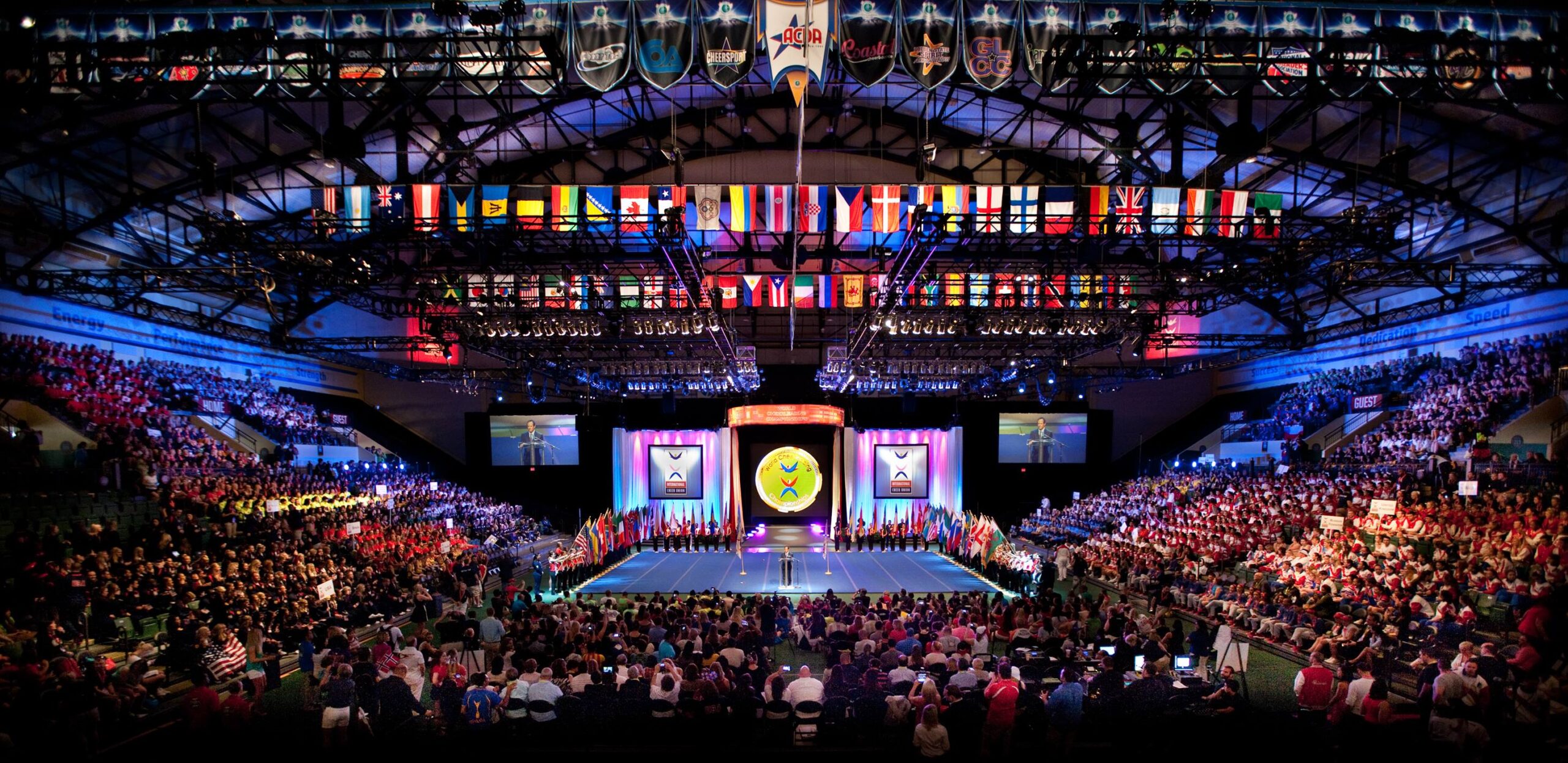
Formation of the International Cheer Union (ICU)
April 26, 2004
As cheerleading expanded rapidly worldwide, Varsity Brands established the International Cheer Union (ICU) in 2004 to serve as a global governing body for the sport. The ICU aimed to unify and standardize cheerleading rules, safety guidelines, and competitive standards across nations, promoting cheerleading as a structured international sport.
Varsity Brands Acquires National Spirit Group
2004
In 2004, Varsity Brands made a major strategic move by acquiring the National Spirit Group, its largest competitor at the time. This acquisition included Lawrence Herkimer’s National Cheerleaders Association (NCA), the Universal Dance Association (UDA), and Cheerleader & Danz Apparel. The merger brought together some of the most respected names in cheerleading and dance under the Varsity umbrella, creating an industry powerhouse. Following the acquisition, Varsity’s annual revenue surged to $244 million, solidifying its dominant position in the cheerleading and dance markets.
USASF Acquires NACCC and Establishes Control Over All-Star Rules
2005
In 2005, the United States All Star Federation (USASF) acquired the National All-Star Cheerleading Coaches Congress (NACCC), agreeing that NACCC would serve as the USASF’s permanent rules committee. This acquisition, conducted in a meeting led by Jeff Webb at Varsity’s Memphis headquarters, granted USASF—and, by extension, Varsity—significant control over rule-making in All-Star cheerleading. Over the following years, NACCC was gradually dissolved, with Varsity, through its influence over USASF, assuming a leading role in decisions affecting rules and regulations within the All-Star cheerleading community. This move solidified Varsity’s influence over All-Star cheer and reinforced its role in shaping the standards and direction of the sport.
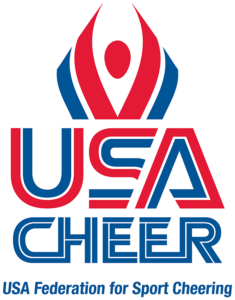
Varsity Launches USA Cheer to Promote and Govern Cheerleading
2007
In 2007, Varsity Brands established USA Cheer (officially the USA Federation for Sport Cheering) as a nonprofit 501(c)(3) organization aimed at supporting and governing cheerleading at both All-Star and school levels. USA Cheer’s objectives include promoting safety and safety education, growing interest and participation in cheerleading across the United States, and representing the U.S. in international cheer competitions. By providing structure and advocating for cheer’s development nationally and internationally, USA Cheer has played a vital role in elevating cheerleading as a respected athletic discipline.

STUNT is Developed as a Title IX-Compliant Cheer Discipline
2011
In 2011, a new cheer discipline called STUNT was developed to expand opportunities for female athletes in a format designed to meet Title IX requirements. While traditional cheerleading is recognized for its athleticism, its dual role as both a sport and a support activity has led the Office of Civil Rights to exclude it from Title IX qualification at the high school and college levels. STUNT was created to address this gap by removing the traditional support role and focusing solely on athletic components. In STUNT, teams compete in a head-to-head, four-quarter format, similar to conventional sports games, rather than performing choreographed routines alongside multiple teams. Each quarter emphasizes different skill elements, including partner stunts, pyramids, and tumbling, bringing a competitive and structured athletic format to cheer. By focusing on competition alone, STUNT aligns with Title IX standards, creating new athletic opportunities for women and allowing cheer athletes to compete in a recognized sport format.
Varsity Acquires Spirit Festival
2011
In 2011, Varsity Brands expanded its competition portfolio by acquiring Spirit Festival, a key competitor known for organizing popular events such as Spirit Fest and Cheer. This acquisition further strengthened Varsity’s position in the cheerleading industry by incorporating Spirit Festival’s well-loved competitions, adding more opportunities for athletes to showcase their skills under the Varsity umbrella. With Spirit Fest’s popularity, Varsity continued to build on its vision of creating diverse, high-quality competitive experiences for cheerleaders nationwide.

Karen Noseff Aldridge Founds Rebel Athletic to Revolutionize Cheer Apparel
2012
In 2012, Karen Noseff Aldridge founded Rebel Athletic with a mission to create the best cheerleading uniforms in the world—focusing on superior value, service, choice, and design. Recognizing that appearance plays a critical role in competitive cheerleading, Rebel Athletic set out to empower teams and gyms to compete on a level playing field by delivering high-quality, customizable uniforms at accessible prices. Operating with the precision and creativity of a fashion house, Rebel Athletic designs its apparel in-house and manufactures in its own offshore facility, allowing for unmatched customization, quality, and quick turnaround. Rebel’s commitment to innovative, fashion-forward designs has made it a go-to brand for cheer teams looking to stand out, while redefining standards for quality and affordability in cheer apparel.
Varsity Acquires BSN Sports for $460 Million
2012
In 2012, Varsity Brands acquired BSN Sports for $460 million, securing its place as the largest provider of team uniforms in the United States, including apparel for competitive cheerleading. At the time of the acquisition, BSN had an extensive sales network with over 800 employees and was a key supplier for schools and sports teams nationwide. Following the acquisition, BSN became a wholly owned subsidiary of Varsity, which enabled Varsity to create the largest "K-through-Colleges" sales force for cheer apparel in the U.S. This move further solidified Varsity's dominance in the cheerleading apparel market, expanding its reach across educational institutions from kindergarten to college.
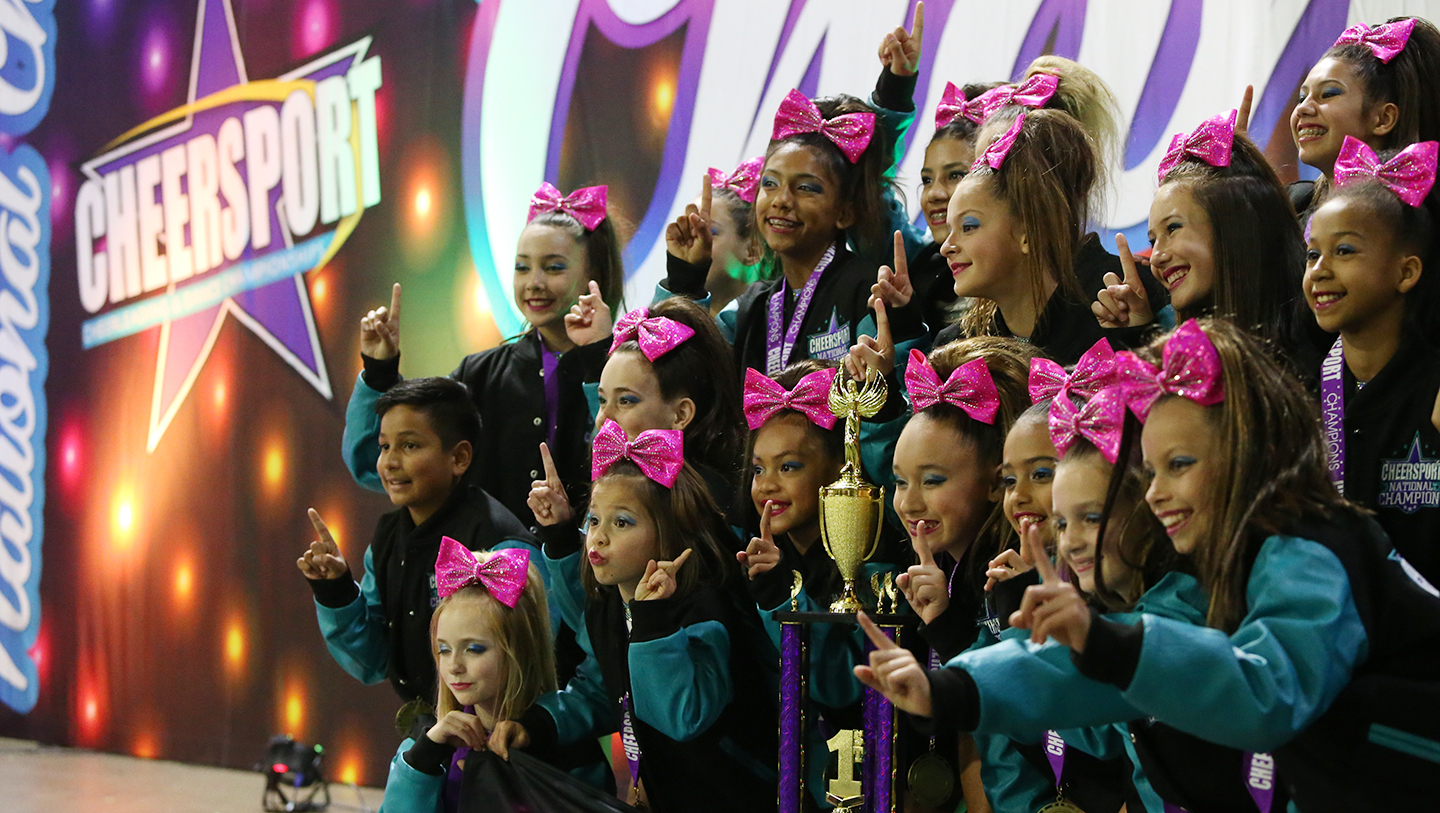
Varsity Acquires CHEERSPORT for $32.9 million
2012
In 2012, Varsity acquired Spirit Holdings, which owned CHEERSPORT, CheerLogistics, and Universal Spirit (collectively “Spirit”). At the time. Spirit was one of Varsity’s largest competitors—promoting over 30 competitions a year—and CHEERSPORT held a National event in Atlanta that attracted over 900 cheerleading and dance teams from around the United States.
ICU, FIG, and SportAccord Sign Trilateral Agreement
August 29, 2012
On August 29, 2012, the International Cheer Union (ICU), the Fédération Internationale de Gymnastique (FIG), and SportAccord (now known as the Global Association of International Sports Federations) signed a historic trilateral agreement. This agreement set the terms under which FIG would support ICU’s admission into SportAccord. Initially, FIG had opposed ICU's membership due to perceived overlaps between cheerleading and gymnastics, particularly in tumbling and acrobatics. However, the trilateral agreement addressed these concerns, allowing FIG to formally endorse ICU's bid. This milestone laid the groundwork for the ICU’s recognition by SportAccord in 2013, cementing its position as the official world governing body for cheerleading and helping to further distinguish cheerleading from gymnastics on the international stage.
International Cheer Union (ICU) Gains Recognition as the World Governing Body of Cheerleading
May 31, 2013
On May 31, 2013, the International Cheer Union (ICU) was officially welcomed as the 109th member of SportAccord (now known as the Global Association of International Sports Federations) after a positive vote by the SportAccord General Assembly in Saint Petersburg. As SportAccord’s 93rd recognized international sports federation, the ICU was designated as the world governing body for cheerleading, holding authority on all matters related to the sport worldwide. This recognition established the ICU’s legitimacy in overseeing global standards, rules, and the development of cheerleading, marking a significant step toward cheerleading’s potential future as an Olympic sport and furthering its acceptance on the international sports stage.
Charlesbank Capital Partners Acquires Varsity for $1.5 Billion
2014
In 2014, Charlesbank Capital Partners acquired Varsity, encompassing Varsity Brands, Inc. and Varsity Spirit, Inc., in a landmark deal valued at $1.5 billion. Following the acquisition, Charlesbank restructured Varsity by converting both Varsity Brands, Inc. and Varsity Spirit, Inc. into limited liability companies (LLCs) under its ownership and control. This acquisition allowed Varsity to benefit from Charlesbank's resources, supporting further growth in cheerleading, school spirit, and athletic markets.
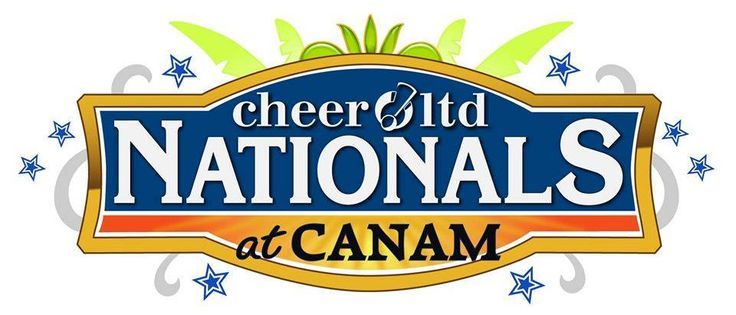
Varsity Acquires Cheer Limited
2014
In 2014, Varsity Brands strengthened its competitive portfolio by acquiring Cheer Limited, one of its largest rivals in the cheerleading industry. At the time of the acquisition, Cheer Limited was producing more than 25 cheerleading competitions annually, including prominent events such as the Cheer Ltd. Nationals at CANAM and the NCHSAA State High School Cheerleading Championship. This acquisition expanded Varsity's influence in the competition circuit, adding popular regional and national events to its offerings and reinforcing its role as a dominant organizer in the cheerleading landscape.
Varsity Acquires The JAM Brands, Its Largest Remaining Competitor
November 2015
In November 2015, Varsity Brands made a major strategic acquisition by purchasing The JAM Brands, its largest remaining competitor and, at the time, the second-largest cheer event producer in the United States. The acquisition was described as one of Varsity’s boldest moves, consolidating nearly 90% of the major cheerleading events under Varsity's control. The JAM Brands had been an Independent Event Producer (IEP) and a significant force in the cheer industry, running popular and large-scale competitions including The MAJORS, U.S. Finals, and JAMFest Cheer Super Nationals, which attracted over 550 competitive cheer teams. Prior to the acquisition, The JAM Brands was known for its innovative approach, introducing competitive event concepts that offered free admission to spectators, a model popular with families and disruptive to Varsity’s fee-based events. The acquisition also gave Varsity control over The JAM Brands' board seats on key regulatory bodies, including the USASF and the International All Star Federation (IASF), solidifying Varsity’s influence over competitive cheer rules and standards. After the acquisition, Varsity initially assured All-Star gym owners that operations would remain unchanged, stating, “For you as a customer, nothing will change.” However, within a year, Varsity increased registration fees for its competitions, leveraging its consolidated position in the cheerleading event market.
Varsity Acquires Allgoods, LLC to Expand Cheer Apparel Market Presence
Late 2015
In late 2015, Varsity Brands further expanded its influence in the cheer apparel market by acquiring Allgoods, LLC, a Texas-based apparel company known for producing custom clothing for schools and programs. Allgoods had generated more than $38 million in revenue, supplying thousands of schools with custom apparel. This acquisition strengthened Varsity’s reach in the cheer and school spirit apparel sectors, enhancing its ability to offer personalized uniform and spirit wear solutions to a broader range of educational institutions.
ICU Gains Provisional Recognition from the International Olympic Committee (IOC)
December 2016
In December 2016, the International Cheer Union (ICU) achieved a significant milestone when it was granted provisional recognition by the International Olympic Committee (IOC). This acknowledgment positioned the ICU as the official world governing body for cheerleading, opening doors to IOC funding and development programs. Provisional recognition marked the first step on the path toward potentially including cheerleading in the Olympic Games, reflecting cheer’s evolution into a globally recognized athletic discipline and further legitimizing it within the international sports community.
Varsity Expands Further with Acquisitions of Key Competitors
2016-2017
Following its acquisition of The JAM Brands, Varsity continued its strategy of consolidating the cheer competition market by acquiring additional event producers, including Aloha Productions, Spirit Celebrations, Mardi Gras Spirit, and Team Epic Brands. These acquisitions further expanded Varsity's dominance, reducing the number of independent competitors and strengthening its control over major cheer events across the country. By incorporating these companies into its portfolio, Varsity secured a larger share of the competitive cheer market, reinforcing its influence over the industry and limiting the avenues for competition in cheer event production.
Varsity Transfers Ownership of USASF Trademarks
2017
Until 2017, Varsity Brands held ownership of the USASF (United States All Star Federation) trademarks, exercising significant influence over the brand and operations of the organization responsible for governing All-Star cheerleading in the United States. In 2017, Varsity transferred ownership of these trademarks, a move that shifted the formal control of the USASF brand while still allowing Varsity to maintain a strong influence over competitive cheerleading through its partnerships and historical ties with the organization.

Varsity and ESPN Open Competitive Cheer Complex at Walt Disney World
2018
In 2018, Varsity Brands collaborated with ESPN Wide World of Sports at Walt Disney World Resort to open a state-of-the-art venue specifically designed for cheerleading and dance competitions. This 8,000-seat, 286,000-square-foot Competitive Cheer complex debuted in January, hosting its first major event, the UCA and UDA College Cheerleading and Dance Team National Championship from January 12-14, 2018. Jeff Webb, Varsity's founder, expressed pride in the project, stating, “Varsity Spirit invented the modern-day cheerleading and dance competition, and we are proud to be the force behind this project, which represents our commitment to providing the very best and safest environment in the world for our athletes and coaches.” This facility stands as a testament to Varsity’s dedication to advancing competitive cheer and dance, offering an unparalleled venue for national and international events.
Bain Capital Acquires Varsity for $2.5 Billion
2018
In 2018, Bain Capital, LP acquired Varsity Brands for approximately $2.5 billion, marking another significant ownership transition for the cheer industry leader. Bain Capital’s acquisition reflected Varsity’s continued growth and influence in cheerleading, school spirit, and athletic apparel markets. Under Bain’s ownership, Varsity has expanded its reach, supporting Varsity’s initiatives in competitive cheerleading, training camps, and apparel.

ICU Receives Full Olympic Recognition from the IOC
July 20, 2021
On July 20, 2021, the International Cheer Union (ICU) received full recognition from the International Olympic Committee (IOC). This official acknowledgment granted the ICU the eligibility to apply for cheerleading's inclusion in future Olympic Games and other multi-sport events. Full recognition by the IOC marked a historic achievement for the cheerleading community, validating cheerleading as a global sport and bringing it one step closer to the Olympic stage.
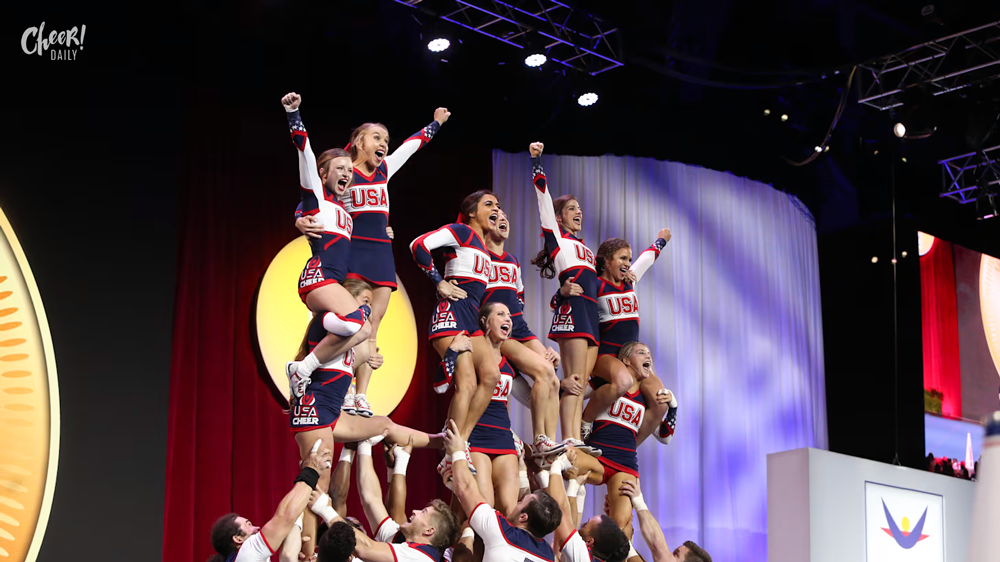
ICU Grows to Encompass 120 Member National Federations
2024
As of 2024, the International Cheer Union (ICU) represents 120 member national federations, highlighting the global expansion and growing popularity of cheerleading. This broad membership base underscores the ICU’s role in unifying cheerleading standards, promoting athlete safety, and supporting the sport’s development across diverse regions. The ICU’s growth and influence further strengthen its standing as cheerleading’s world governing body, fostering opportunities for athletes worldwide.
KKR Finalizes $4.75 Billion Acquisition of Varsity Brands
August 26, 2024
On August 26, 2024, private equity firm KKR completed its acquisition of Varsity Brands from Bain Capital and Charlesbank in a transaction valued at approximately $4.75 billion, including debt. This major deal shifts majority ownership of Varsity Brands, a leading entity in the cheerleading, dance, and spirit industry, to KKR. As part of its strategic vision, KKR plans to implement an employee equity program to further support Varsity Brands’ growth. The acquisition was primarily funded through KKR’s North America Fund XIII and aligns with KKR's ongoing investments in the sports and athletic sector. Varsity Brands encompasses key divisions such as BSN Sports, the largest U.S. team dealer and sports outfitter, and Varsity Spirit, which serves a broad customer base in the cheerleading and team sports market. Together, these divisions reach over 150,000 customers, including colleges, universities, club teams, and recreational programs. This acquisition follows Bain Capital’s 2018 purchase of Varsity Brands for around $2.5 billion. Recent discussions about a potential sale or IPO valued Varsity Brands at over $6 billion, but KKR’s acquisition at $4.75 billion secures a competitive stake in the expanding cheer and spirit market.







